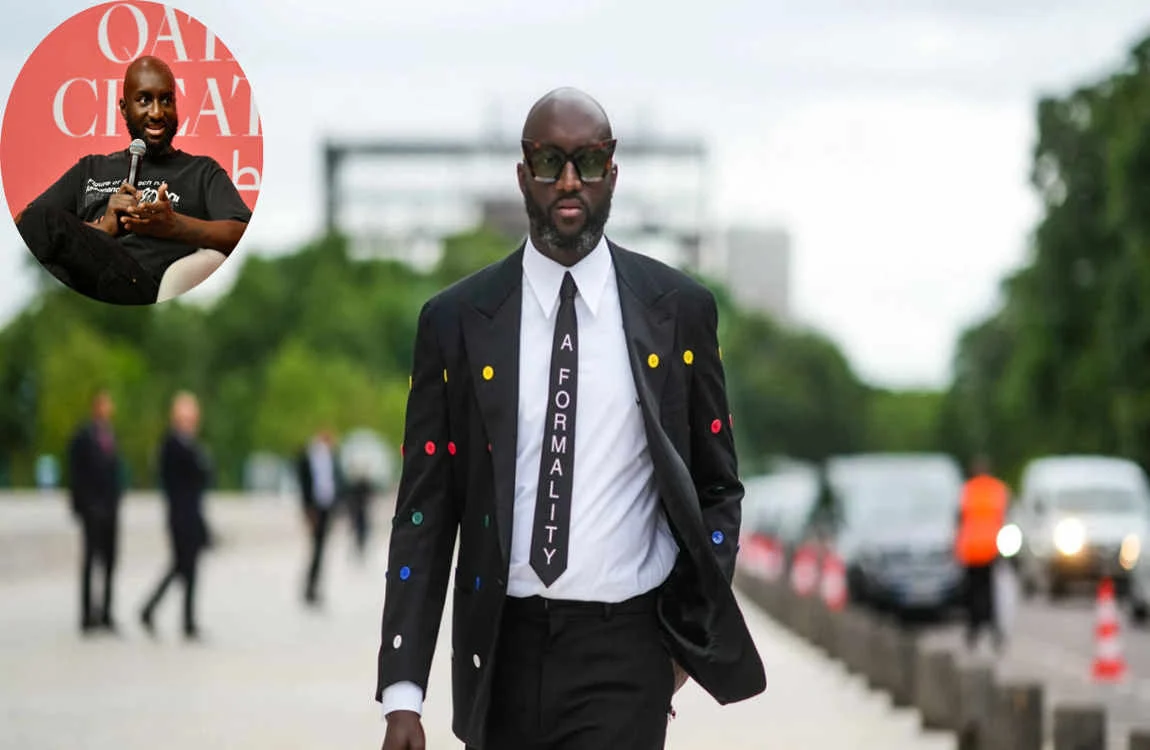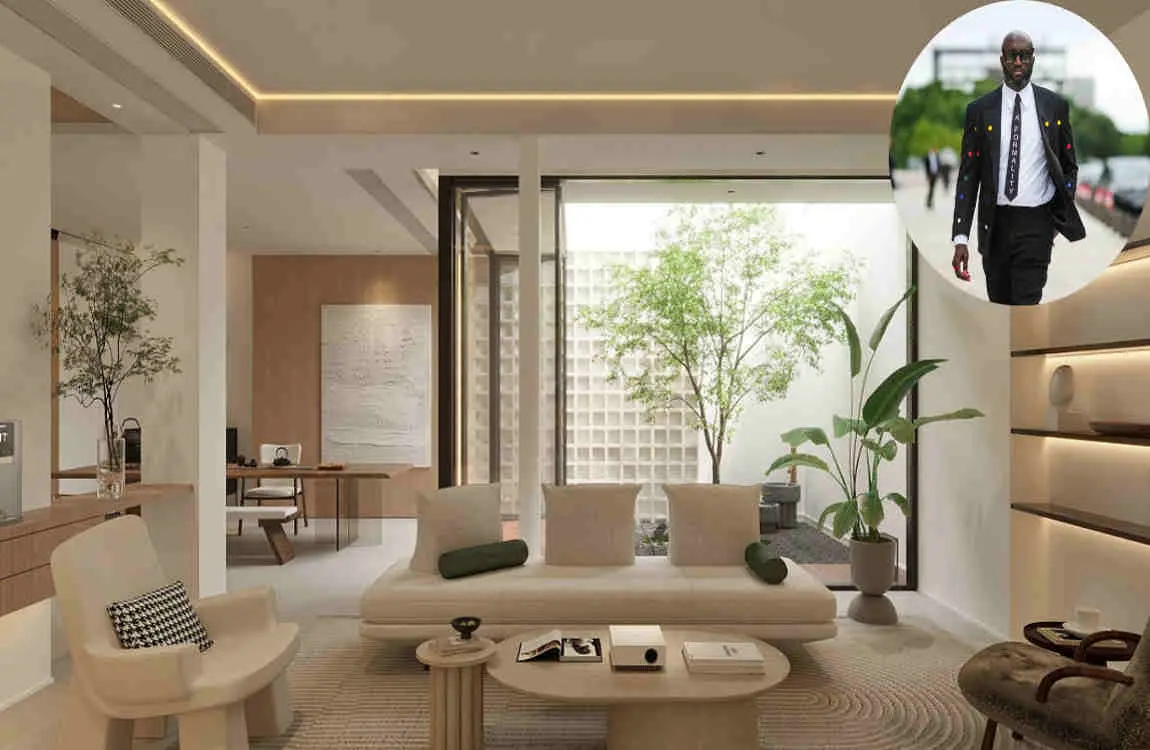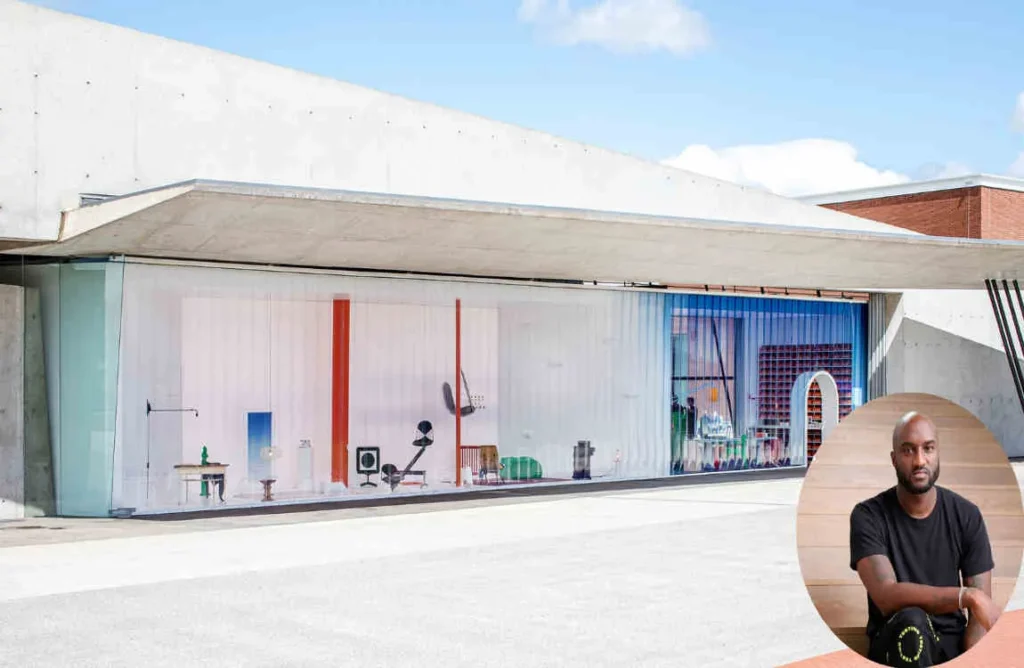Virgil Abloh was a creative genius who left an indelible mark on the worlds of fashion, architecture, and design. Known as the founder of Off-White and the Artistic Director of Louis Vuitton Men’s, Abloh’s influence extended far beyond the world of clothing. His visionary approach to design seamlessly blended architecture, art, and interior aesthetics, creating spaces that were both innovative and functional.
Virgil Abloh: The Designer Behind the Vision

A Background Rooted in Architecture and Engineering
Before becoming a household name in fashion, Virgil Abloh’s journey began in the world of architecture and engineering. He earned a degree in civil engineering from the University of Wisconsin-Madison and later pursued a master’s in architecture at the Illinois Institute of Technology. This academic foundation shaped his design philosophy, giving him a unique perspective on space, structure, and functionality.
Abloh’s architectural training was evident in his work, where he often blurred the lines between disciplines. His ability to merge the technical precision of engineering with the creativity of design allowed him to create spaces that were both innovative and deeply personal.
The Philosophy of “Making the Familiar New”
One of Abloh’s guiding principles was the idea of “taking the familiar and making it new.” This philosophy was evident in everything he touched, from his Off-White™ collections to his interior designs. By reinterpreting everyday objects and spaces, Abloh created a personal design language that was both relatable and revolutionary.
Concept and Architecture of the Virgil Abloh House
A Unique Architectural Vision
The Virgil Abloh house was a testament to his architectural prowess. Designed as a twisted form of three interconnected blocks, the house revolved around a central staircase. This layout emphasized movement, natural light, and the seamless division of space. The design wasn’t just about aesthetics—it was about creating a home that felt alive, dynamic, and connected.
You may also read (inside leah reminis luxurious home a sneak peek).
Inspiration from Modernist Principles
Abloh’s architectural vision was heavily influenced by modernist principles, particularly those of Mies van der Rohe and the Bauhaus movement, which had a significant presence in Chicago. Clean lines, open spaces, and a focus on functionality were central to his design. Yet, he added his twist, infusing the space with a sense of fluidity and creativity that reflected his personality.
Interior Design Philosophy: Modernity Meets Familiarity
The “3% Approach” to Design
One of Abloh’s most famous design principles was his “3% approach.” This concept involved making subtle edits to existing forms to create something fresh and modern. Rather than reinventing the wheel, Abloh believed in enhancing what already existed. This philosophy was evident in his interiors, where small but impactful changes transformed ordinary spaces into extraordinary ones.
Neutral Palettes with Bold Accents
The interiors of the Virgil Abloh house were a perfect blend of minimalism and boldness. Neutral tones, such as white, beige, and gray, formed the base, while vibrant pops of color—like fluorescent orange and pink—added energy and personality. This balance between subtlety and vibrancy was a hallmark of Abloh’s design style.
Sophistication Meets Relatability
Abloh’s interiors were sophisticated yet approachable. He believed that design should be both visually appealing and functional. By combining high-end materials with relatable elements, he created spaces that felt luxurious yet approachable.
Key Interior Elements and Signature Features of Virgil Abloh’s House

Modular Design for Adaptability
One of the standout features of the Virgil Abloh house was its modular design. Inspired by his collaboration with Cassina, Abloh incorporated matte-black modular blocks that could serve as seats, tables, or benches. This emphasis on adaptability and sustainability reflected his forward-thinking approach to design.
Unique Materials and Finishes
Abloh’s use of materials was anything but ordinary. From recycled wood cores to polyurethane upholstery and anti-fingerprint coatings, every element was carefully selected to strike a balance between aesthetics and functionality. Bold graphic logos and industrial finishes added a touch of his signature style.
Branding and Graphic Motifs
As the founder of Off-White™, Abloh’s Branding was an integral part of his design. The house featured graphic motifs, such as the swimming man logo, Off-cross, and meteor holes, seamlessly blending fashion and interior design. These elements added a playful yet sophisticated touch to the space.
Ceramics and Textiles
Abloh’s love for craftsmanship was evident in the ceramics and textiles used throughout the house. Delftware-inspired ceramics and minimalist textiles showcased his ability to merge traditional techniques with modern aesthetics.
Virgil Abloh’s Vision for the Future Home
Reinterpreting Iconic Furniture
Abloh’s vision for the future of home interiors was nothing short of revolutionary. He reimagined iconic furniture pieces from designers like Jean Prouvé and the Eames, envisioning how they might look and function in 2035. This futuristic approach challenged conventional design ideas and encouraged innovation.
Modularity and Sustainability
Abloh believed that the homes of the future should be adaptable and sustainable. His designs emphasized modularity, allowing spaces to evolve in response to the needs of their inhabitants. By using eco-friendly materials and multifunctional furniture, he paved the way for a more sustainable approach to interior design.
Blending Art and Function
For Abloh, design was about more than just aesthetics—it was about creating spaces that were both beautiful and functional. His work blurred the lines between art and utility, inspiring a new generation of designers to think outside the box.
The Impact of Virgil Abloh’s Interior Design on Contemporary Spaces
Challenging Traditional Norms
You may also read (inside mike repoles dream home a visual journey).
Abloh’s approach to interior design challenged traditional norms by blending streetwear culture, luxury, and architecture. His work proved that high-end design could be both accessible and innovative, inspiring creatives across industries.
Influencing Modern Interiors
The influence of Abloh’s design principles is evident in modern home interiors and furniture design. From modular furniture to bold graphic elements, his ideas continue to shape contemporary spaces.
Inspiring Creativity Beyond Fashion
Abloh’s design language extended far beyond the realm of fashion. His ability to tell stories through spaces and objects inspired creatives in fields like architecture, interior design, and visual storytelling.
How to Incorporate Virgil Abloh’s Design Elements into Your Own Home
Practical Tips for Homeowners
Want to bring a touch of the Virgil Abloh house into your own space? Here are some practical tips:
- Embrace Subtle Innovation: Apply the “3% approach” by making small but impactful changes to your interiors.
- Play with Color: Use neutral palettes as a base and add pops of bold color for contrast.
- Invest in Modular Furniture: Look for multifunctional pieces that can adapt to your needs.
- Incorporate Branding Thoughtfully: Add graphic elements or logos in a way that feels personal and intentional.
Sourcing Abloh-Inspired Pieces
If you’re looking to recreate Abloh’s style, consider exploring the Off-White™ HOME collection or similar modular furniture lines. These pieces capture the essence of his design philosophy, offering both practicality and style.
You may also read (inside kris kristoffersons iconic home a virtual tour).

